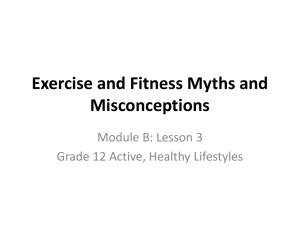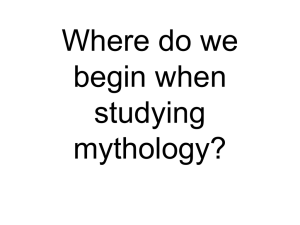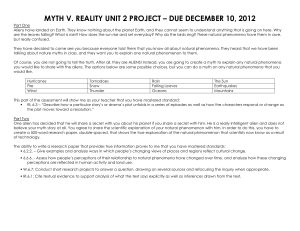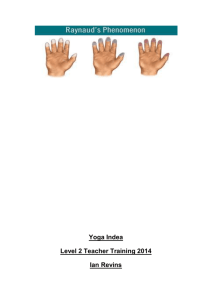Create a list of natural phenomena and wonderings.
advertisement
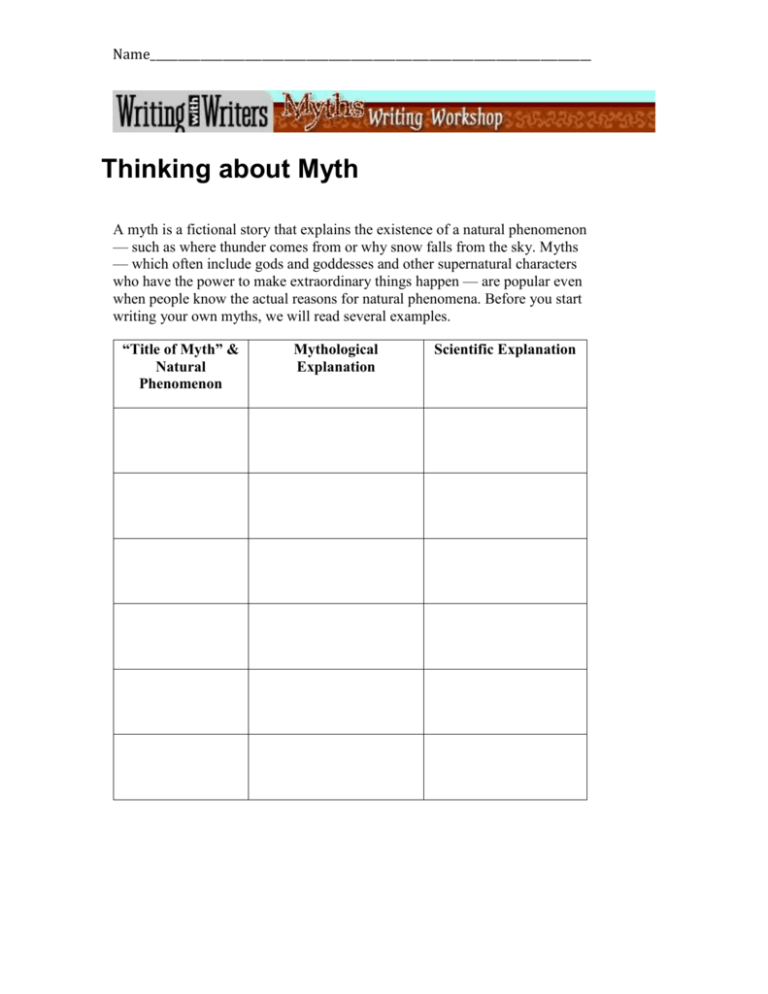
Name_______________________________________________________________________________ Thinking about Myth A myth is a fictional story that explains the existence of a natural phenomenon — such as where thunder comes from or why snow falls from the sky. Myths — which often include gods and goddesses and other supernatural characters who have the power to make extraordinary things happen — are popular even when people know the actual reasons for natural phenomena. Before you start writing your own myths, we will read several examples. “Title of Myth” & Natural Phenomenon Mythological Explanation Scientific Explanation Name_______________________________________________________________________________ Brainstorming Myths are stories that explain a natural phenomenon. Before humans found scientific explanations for such things as the moon and the sun and rainbows, they tried to understand them by telling stories. These tales remain popular today. As you start to think about writing your own myth, try these warm-ups. They should help you begin to plan your story. Follow these three steps. 1. Look back to your list of natural phenomena and wonderings Starter. Choose one to be the subject of your myth. Make it something that really interests you! 2. Use the Gathering Grid to record what is actual about the phenomenon or wondering. It helps to know a thing well before trying to make up a story about it. The old myths were created by poets and storytellers who were well-acquainted with nature. Find out as much as you can about the natural phenomenon or wondering that you've chosen. Go to the library or online to find out what it is scientifically — and read what other storytellers have said about it. 3. Ask yourself, WHAT IF? Hop onto your concept and head off into myth land. This is the point from which you need to start brainstorming! Take a picture in your mind of what an aspect of the world would be like if certain events happened. Then use this "what if" strategy to create a story that explains why the natural phenomenon or answer to your wondering exists. The story can be as fantastic as you want. For example, What-if there was a chef to the gods who lived in a beautiful green countryside but became upset one day because no one ever complimented his cooking? While wandering around, he sat under one of those beautiful green trees and wished (always be careful what you wish for in a myth) that he could somehow make the gods take notice. And suddenly in front of him was a special pepper grinder that said, "Use me, and you will be noticed." And so the chef took the pepper grinder and used it that evening as he was seasoning the gods' stew. But instead of churning out pepper, it ground out sand — more sand than the chef had ever seen! The sand kept pouring out, completely covering the beautiful green countryside. And thus the desert came into existence. Name_______________________________________________________________________________ Your Topic:____________________________________________________ In the box below, begin brainstorming some “what-if…” scenarios that relate to your subject. Refer to the example about the desert and the pepper grinder for guidance. Mandatory: Complete the Five W’s Chart in ink. (25 points) Optional: Keep a record of what you have observed or read. What are the smells, sights, and sounds connected to this natural phenomenon? If you are artistic, you might want to try drawing sketches or painting pictures. Name_______________________________________________________________________________ Mother Earth's Son Long ago, when Mother Earth lived by herself, far from her sisters and brothers, the stars, she was lonely. She was so lonely, she decided to make a family for herself. So she fell asleep under a blanket of ice, and when she woke up, she was the mother of a beautiful baby boy. Now, like all little babies, the little boy was at first easy to handle. He slept a lot and ate very little, and Mother Earth carried him about on her back in a sling woven of grass and reeds. When the baby was tired, she sang to him. "Oh little son of mine, little baby, the stars who are your uncles and aunts look down and send sweet dreams. Dreams like sugar cane, like the bees' honey." And he would fall asleep without a bit of trouble. But as the boy grew older and began to walk and then to run, he would sometimes get into trouble. He would fling things around and splash in puddles. He would take water into his mouth and spit it all over the place. Then he would laugh and laugh, thinking this mischief was very funny. His mother scolded him in all the languages of the earth. She would say "Little son, kleine mann, toto, mi nino, what are you doing? Do not treat your mother this way." Like all children, for the most part he was sorry, and tried hard to be good. But every once in a while, the mischief in his head got into his hands and feet and mouth, and then he made a mess. Everywhere. Today we know this boy by one of his mother's pet names. Have you figured out yet what it is? Do you think you know what this is? The answer is El Niño (Spanish for "the child"), which is a big pool of warm water that forms in the Pacific Ocean. El Niño happens once every four to ten winters when strong winds blowing from the northeast push lots of warm Pacific Ocean water together. The water then generates warm air that is whipped into the atmosphere. When the winds stop blowing, the big pool of warm water starts to drift east. El Niño can contribute to flood conditions across North and South America. Name_______________________________________________________________________________ Starter Create a list of natural phenomena and wonderings. Natural Phenomena A single rainstorm can cause a flood in the desert A snowstorm can cover the ground like an icy blanket The ocean tide comes in and out each day Wonderings Why is the sky blue? How does a battleship float? Can a river catch on fire? Is it possible for someone to never sleep, ever, at all? How do streets get their names? Name_______________________________________________________________________________ Gathering Grid A gathering grid can help you organize information for a research report. Write your questions in the left hand column Write the title of our sources at the top of each column Write answers you find TOPIC Question 1 Question 2 Question 3 Source 1 Source 2 Source 3 Name_______________________________________________________________________________ Example Gathering Grid TOPIC: TORNADOES twister.com How do they form? National Geographic A warm and a cold front clash and make a supercell. (p.120) Where are they found? Throughout the world, though mostly in Tornado Alley in U.S. (p. 13) How do they Wind throws cause damage? objects; hail smashes stuff. When do they form? Tornado! March through early July Low pressure rips off roofs. (p. 122)




